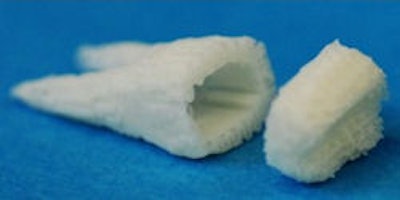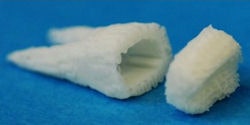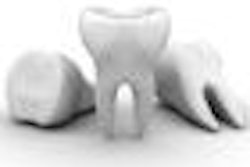
Researchers at Columbia University have claimed another advance in the quest to grow biological teeth that could eventually be used instead of implants.
Writing in the Journal of Dental Research (May 6, 2010), the researchers said they had used growth factors to stimulate cells to grow along a scaffold in the shape of a human molar and also in the shape of a rat incisor.
Researchers in previous experiments have been able to grow teeth by culturing tooth germ cells in laboratories, then implanting them in mice. But using this approach in humans is difficult because tooth germ cells are hard to obtain and the approach could be costly to commercialize, according to the Columbia researchers.
So they tried creating teeth by building 11 rat incisor-shaped scaffolds and 11 human molar-shaped scaffolds out of 80% polycaprolactone and 20% hydroxyapatite. They infused these scaffolds with growth factors. They also created 11 similar scaffolds without growth factors as a control.
The researchers implanted the human molar-shaped scaffolds in pouches under the skin of 11 rats, and placed the incisor-shaped scaffolds in the place of natural incisors they had extracted.
 |
| Human molar scaffolding, grown in the Tissue Engineering and Regenerative Medicine Laboratory at Columbia University Medical Center. This technique has the potential to yield an anatomically correct tooth in as soon as nine weeks once implanted. Image courtesy of Columbia University Medical Center. |
After nine weeks, they killed the rats and removed the scaffolds. They found that the rat incisor had integrated with surrounding tissues, including new alveolar bone, blood vessels, and fibrous tissue reminiscent of periodontal ligament. Many more cells homed into the scaffolds with growth factors than those without.
Host cells populated the human molar scaffold as well, creating blood vessels and mineral tissues, once again in greater numbers on the scaffolds where the growth factors were used.
"These findings represent the first report of regeneration of anatomically shaped toothlike structures in vivo, and by cell homing without cell delivery," noted Jeremy Mao, a professor of dental medicine at Columbia, and his colleagues. "The potency of cell homing is substantiated not only by cell recruitment into scaffold microchannels, but also by the regeneration of periodontal ligaments and newly formed alveolar bone."
Copyright © 2010 DrBicuspid.com



















